Creative tips to work like a pro
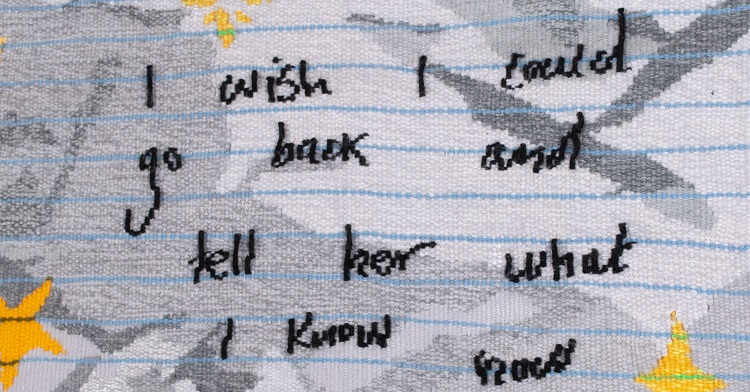
It’s a big YES! How many of us really say yes to life, say yes to loving our art and making time for it? Do you give yourself permission to follow the wonderful journey towards your happiest art dreams? Or do you procrastinate, feel unworthy, block and sabotage yourself, turn the other way? What if you took a deep breath and surrendered – whether you call it good fortune, grace, the divine, the universe or simply self-love – what if you really said ‘yes’ to that?
You may be happy stitching, knitting, collaging, cutting and creating, whether that’s in a structured or more intuitive way. You might make art for your own amusement, for gifts, to exhibit or to sell. But, what if there’s an urge to take it further? What if you’d quite like to make a statement piece that conveys a message, or share your work with the wider world?
If you’ve ever thought about turning your passion for textile art into a more serious occupation, the first step is to find the right mindset. We asked five professional textile artists, Shelley Rhodes, Danny Mansmith, Woo Jin Joo, Molly Kent and Trish Burr, about their own paths to success and for their tips on getting there.
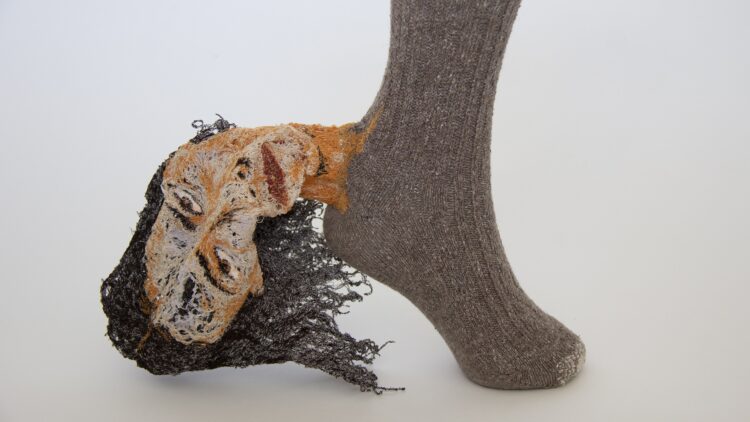
Find your ‘why’
‘If we want to feel an undying passion for our work, if we want to feel we are contributing to something bigger than ourselves, we all need to know our WHY.’ – Simon Sinek, Find Your Why: A Practical Guide for Discovering Purpose for You and Your Team.
First, ask yourself why you want to step up with your art. Are you looking to feed your need for creativity, perhaps after retiring from another career or to support your own mental or physical health? Do you want to earn a living from it? Are you keen to exhibit your work? Or craving the buzz and satisfaction of creating your own unique work but struggling to gain focus?
Once you’ve worked out your aims, you need to find the willpower to fulfil them. Adopting a professional mindset is quite different to choosing to do your art as a part-time hobby.
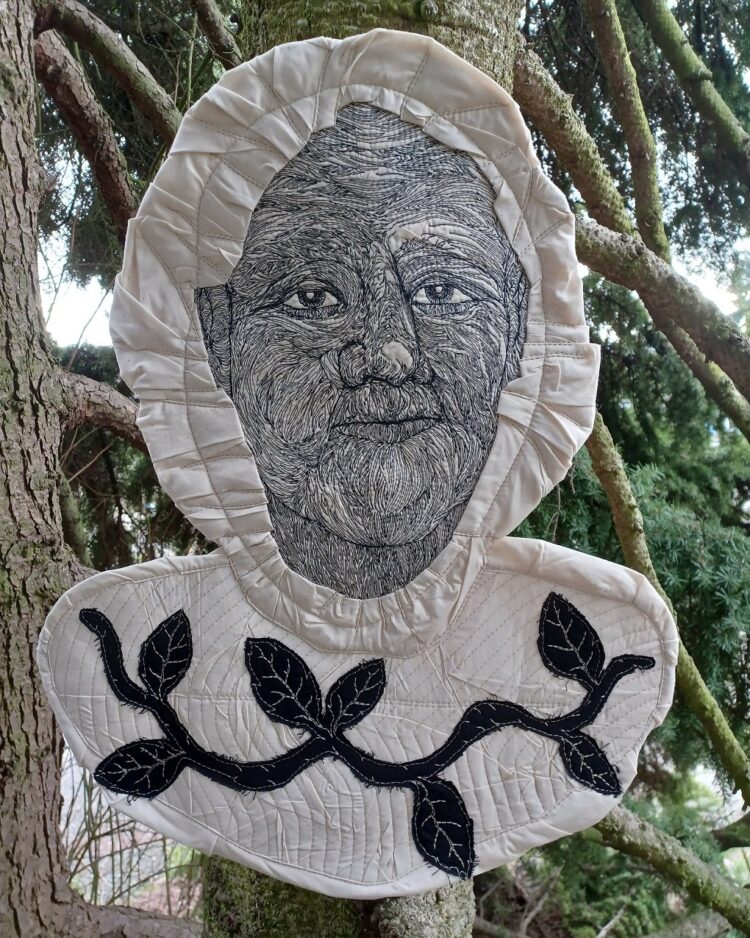
Danny Mansmith
Danny Mansmith began his art career in childhood. He was nurtured by his mum, his great aunt and his grandma who instilled in him the ability to see the creative possibilities in the things around them. Danny’s path wasn’t straightforward, but his self-motivation was key.
Teach yourself
Danny Mansmith: ‘I’m an artist who’s kept a conversation going with my sewing machine since the early 1990s. I spent a year at a small art school but I wasn’t very good at following instructions and so I left to teach myself instead. I became inspired to make my own clothes: the idea of looking and dressing in my own style felt important somehow. In the first month, I took apart almost all of my store bought clothes to try to follow the patterns and teach myself about garment construction.
‘Through the years I continued to teach myself how to use the sewing machine. When I finally felt confident, I got my first job sewing for an artist who made baby blankets and accessories.
‘My boss encouraged me to apply for some local art fairs and that was a turning point for me, helping me realise that I could make my way in the world as a working artist.’
‘Making things makes me happy – working with my hands and creating a space where ideas are free to come out and manifest in front of me. The sewing machine is both an inspiration and the tool I use. My home studio is both a sanctuary and workspace, where I keep my love of drawing alive with my daily practice.’
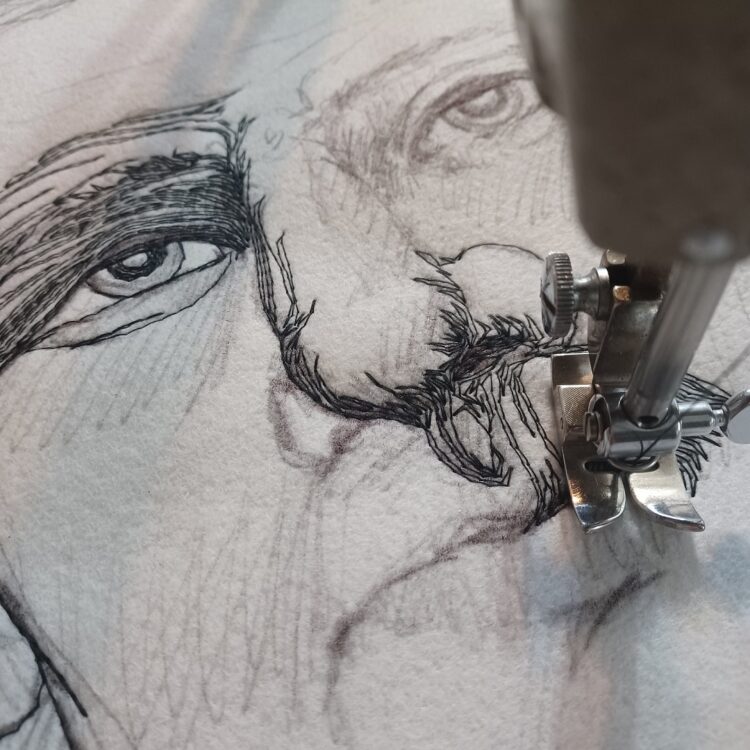
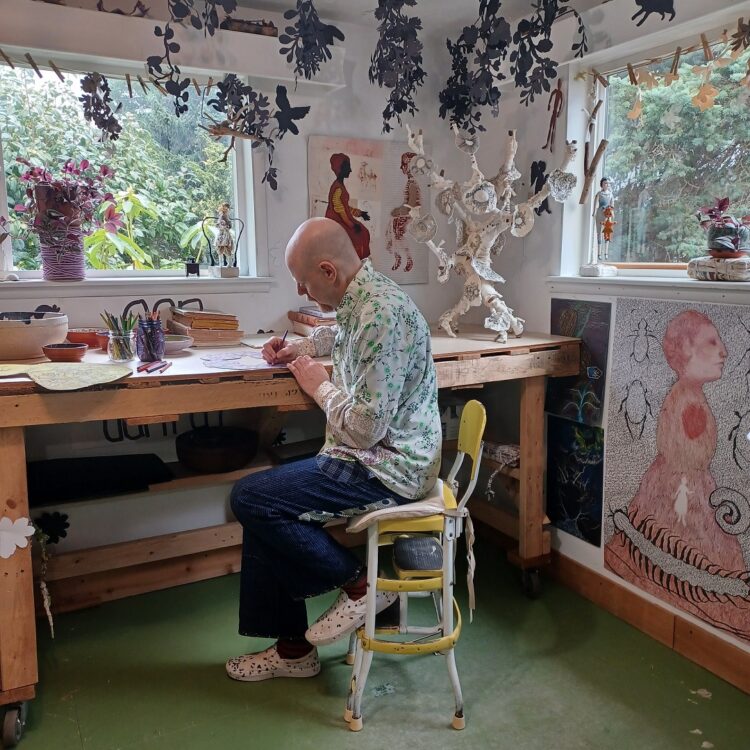
Danny Mansmith is based in Burien, Washington, US and has a strong connection to the midwest and Chicago, Illinois. His solo show ‘We All Become Myth’ exhibited at The Highline Heritage Museum in Burien, Washington, March-April 2023.
Artist website shop: dannymansmith.bigcartel.com
Facebook: facebook.com/danny.mansmith
Instagram: @dannymansmith
Take action daily
Making time each day to create is the secret to a committed and regular practice. Set yourself some boundaries and rules to guide you. This could be 20 minutes a day, or free play, daily sketchbooking, journaling or daily mindful stitching. Be realistic about the time you have available. Small daily actions will help you to overcome resistance and continual action will lead to inspiration and progress.
Your creativity is likely to flow more readily if you can allow yourself space and time without any pressure. Unless you’re working on commissions, don’t try to make art to order, or pressurise yourself to be creating exhibition-worthy art at all times. Every action related to your art is part of your practice – just make sure you treat it with a professional mind-set.
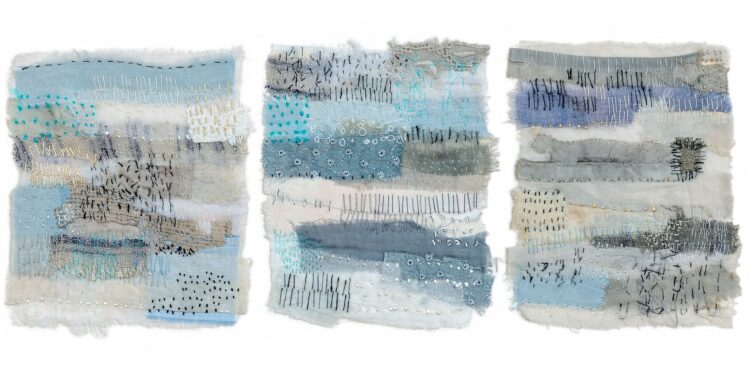
Shelley Rhodes
Shelley Rhodes: ‘My daily Instagram posts began as a challenge to make me draw regularly. However, over the years I have shifted slightly, so my post might be a collage, assemblage, printing or mark-making, exploration of materials, a stitch sample, or ongoing work. This habit encourages me to notice and respond, then explore ideas and materials more fully. Some ideas feed into my work, but not always.
‘Sometimes I simply take pleasure in drawing and recording what I see. In 2022, these posts led to an exhibition of my sketchbook pages The Sketchbook at Llantarnam Grange Arts Centre in South Wales. A few years ago, I was asked if I would sell my daily artwork and this has become a great additional source of income. When I post my work online, I never know who is going to see it, or what it might lead to. My daily posts have increased interest in my work, which has led to sales of artwork and books, exhibitions and teaching opportunities.’
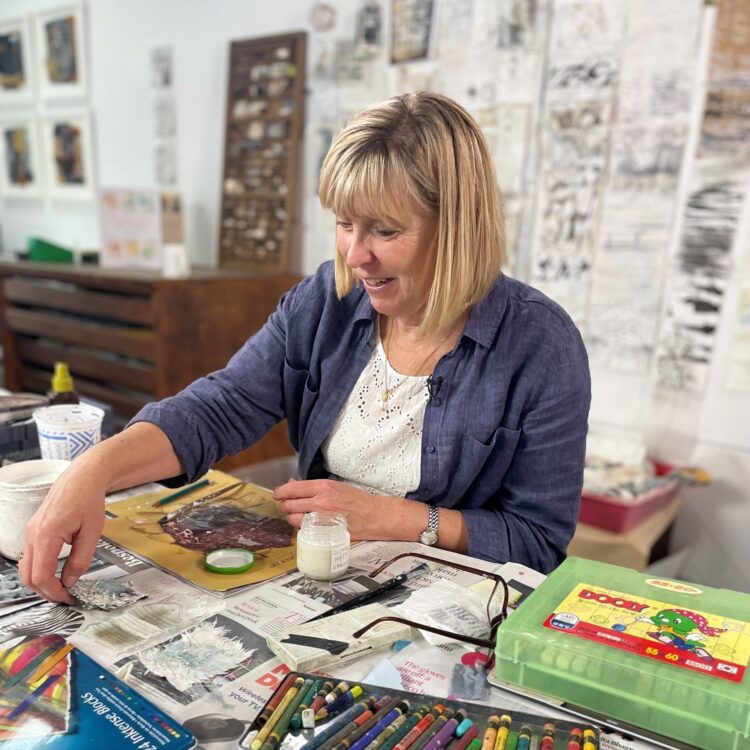
Shelley Rhodes is based on the border between Lancashire and Cumbria, England. She makes mixed media work focusing on fragmentation, reconstruction and repair.
Artist website: shelleyrhodes.co.uk
Facebook: facebook.com/shelleyrhodesmixedmediaartist
Instagram: @shelleyrhodesartist
Stay curious
Having a professional attitude means developing the positive attributes of discipline, persistence and determination. Both Danny and Shelley maintain their commitment with a daily art practice. If you’re feeling an urge to be creative, then allow yourself the time to satisfy it. Set aside time to focus on making art – no matter what. If you make it a priority, rather than an occasional pleasurable activity, then you’ll create a regular practice through your discipline and determination.
But how do you focus? With the plethora of information available on the internet, it’s easy to get bogged down with learning yet more techniques, rather than developing those you know. Guard against this temptation and concentrate on what you’re really interested in.
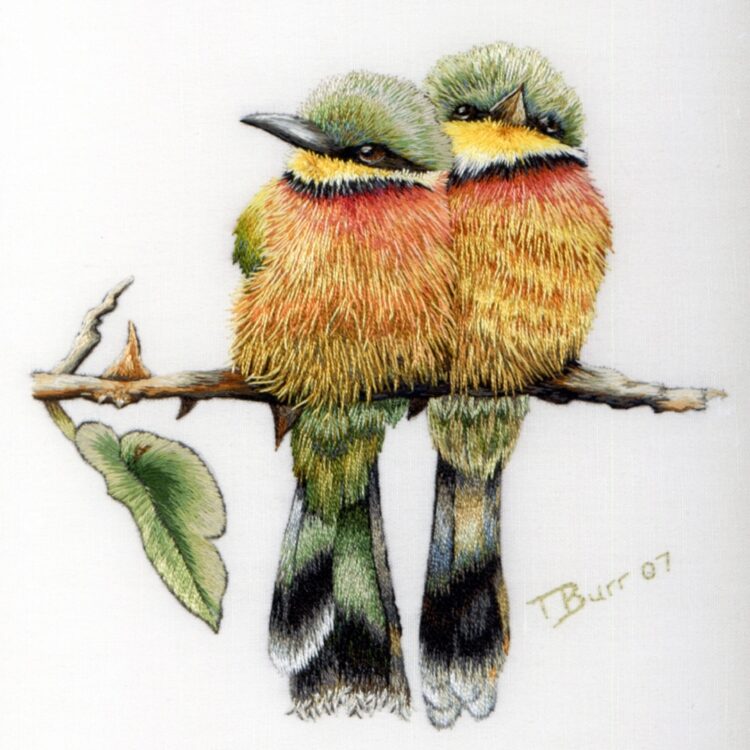
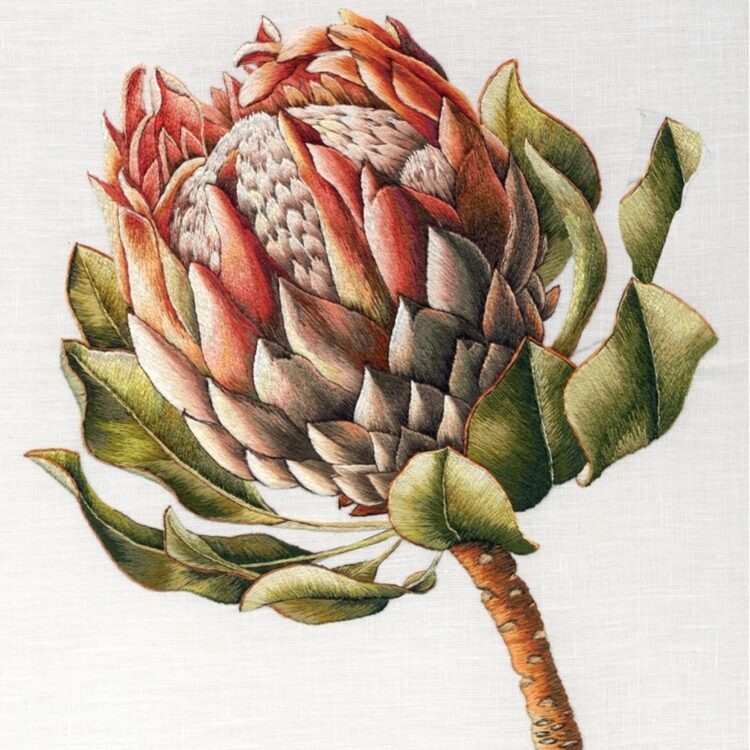
Trish Burr
Embroidery artist, educator and author Trish Burr started her craft when she was a young mother in Zimbabwe. She found cross stitch too limiting and so she began to experiment with thread painting. Because patterns and materials were not available and there were drastic foreign currency restrictions, Trish had to use whatever she could find. She chose pictures from books, postcards and calendars, trying her best to replicate them with needle and thread.
Trish Burr: ‘I had no formal training so I created my own style of needle painting – a new form of long and short stitch was born. This simple method, which I have honed and crafted over the years, is what I still use today.
‘When I moved to Cape Town I was asked to teach at some local conventions. My students struggled with the technique and were generally very nervous of it, so I made it my mission to simplify, simplify. I tried to put myself in the shoes of my students – I spent many months with a doodle cloth and notebook, making notes and thinking of different approaches which would make my instructions clear.
‘I think this was a turning point in my career – as my instructions improved, my patterns became more popular, and the demand for my work increased.’
Determination and focus
‘Another watershed moment was when I began to explore how colour affected my embroidery. Needle painting is known for its beautiful, shaded appearance, and I wondered why some works looked flat and dull while others had a radiant glow. I spent years researching and experimenting with how colours interacted with each other. I realised that there was a whole world of colour combinations – it was time to break free from traditional limitations.
‘Once, I was trying to recreate the vibrant greens of a bird’s feathers, when a man came to fix our television. It turned out he was an artist. He helped me to understand that you don’t need to use brighter shades of green, but if you create a contrast in the greens it will bring vibrancy. My explorations eventually led me to write the book Colour Confidence In Embroidery.’
Trish’s success can be put down to her determination and focus, which in turn brought about fortuitous events that she could not have made happen. The moral is – begin it!
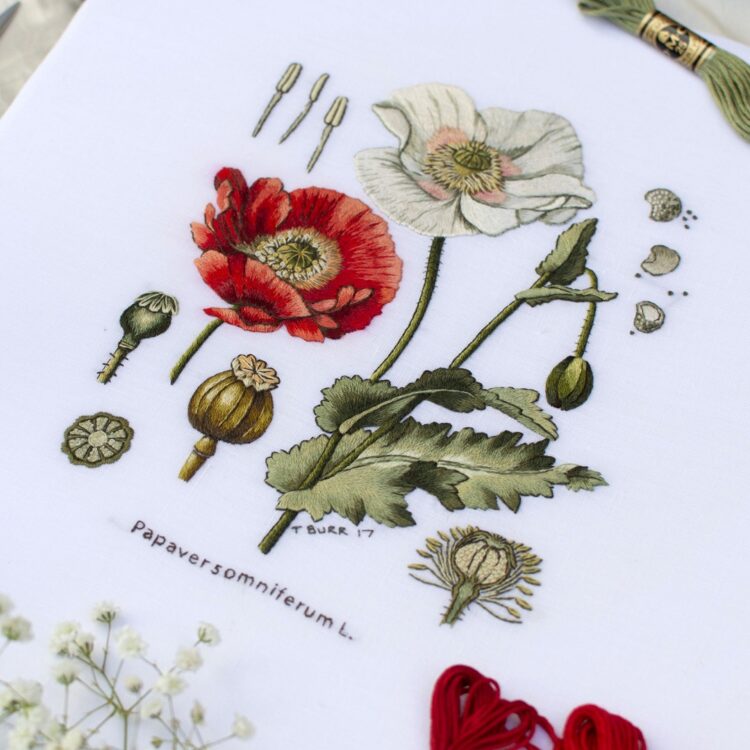
Embracing technology
Trish’s challenges did not, however, end there. Trish had to overcome the era of technological revolution, which without determination could have been another cause for procrastination.
‘When I began embroidery, there was no internet, no websites and no online sales. Over the years I had to learn how to manage my own website, produce patterns in different formats for print and PDF, and ship my products worldwide.
‘I purchased the first version of the graphics software CorelDRAW and began to explore drawing my own diagrams and outlines for embroidery. This was life changing for me. I still use the same software program for my designs – I’ve become adept at drawing with a mouse, in fact it now feels awkward to draw with a pencil. I had to get to grips with social media and marketing. When I published my first book I pasted pictures into a spiral bound notebook and manually wrote out the text, but now it is done with computer software and digital photography.
‘It was a constant challenge to juggle my home life with my ever evolving embroidery business, as well as find time to sit quietly and stitch. There came a time when the increased demand was such that I had to choose whether to expand and employ staff, or stay small and personal. I decided on the latter because I wanted time to do what I love, which is to design, stitch and teach. However, I did need some help. The solution came when I attended a talk where the speaker mentioned the benefits of virtual assistants – they handle all the admin, which frees me up to focus on the core work. My assistants in India are always available to help, and I could not do without them!’

Trish Burr is based in Cape Town, South Africa. She is an embroidery artist specialising in needle painting and whitework embroidery. In the last two decades she has published 11 books, created embroidery patterns, tutorials and videos, and has taught both at home and abroad.
Artist website: trishbembroidery.com
Facebook: facebook.com/needlepainting
Instagram: @trishburrembroidery
Overcome the negative voice
Much has been written about how to deal with the negative voice in your head.
On her website, artist and author SARK talks about procrastination, as well as the inspiration, motivation and synchronicities that propelled her to success as an artist.
SARK: ‘As someone who has sold over two million books in the last 30 years, it may surprise you to know that I too have experienced procrastination, perfectionism and fears about writing or ever sharing my unique gifts with the world.’
But SARK overcame that to go on to sell her art products and write many inspirational books, including Make Your Creative Dreams Real.
Author Steven Pressfield has written several motivational books including The War of Art: Winning the Inner Creative Battle and Do The Work: Overcome Resistance and Get Out of Your Own Way. He is quoted as saying: ‘Most of us have two lives. The life we live and the unlived life within us. Between the two stands resistance.’
If you struggle with inner blocks, then this idea is worth exploring. As artists and many others have shown, it really is possible to put a stop to resistance.
Internet addiction is a form of procrastination, distracting us from our own work. Do you ever scroll through Instagram while feeling like your work isn’t good enough to share? A great way to overcome perfectionism is by sharing your work, whether that’s on Instagram, Facebook or, like Shelley Rhodes and Sue Stone when they started off, by taking part in a small local exhibition.
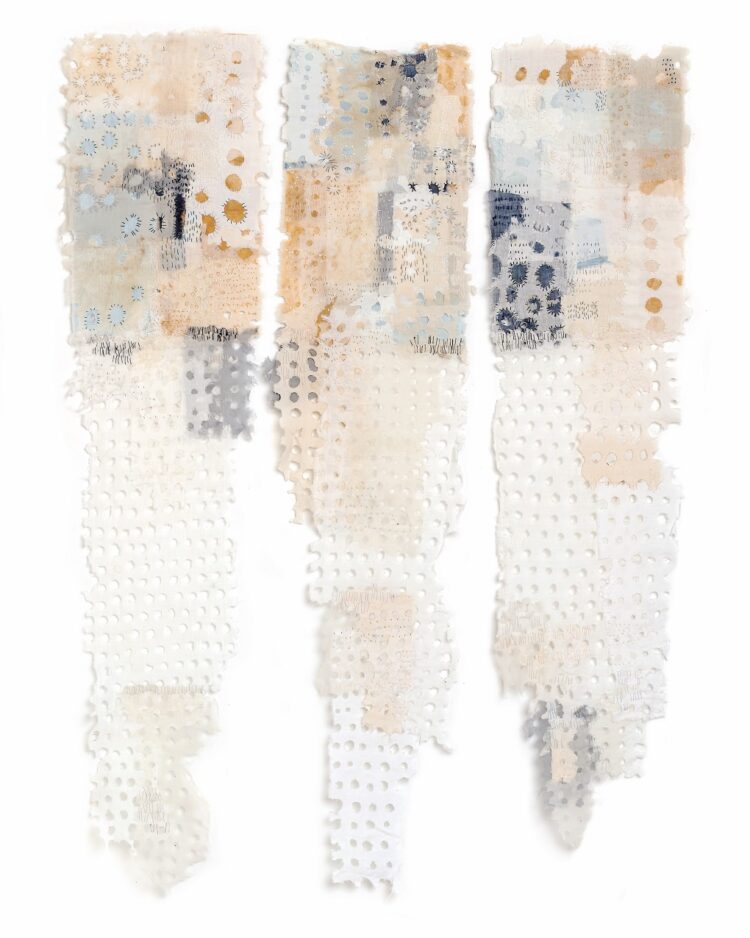
Fighting fear and self-criticism
Keeping busy with other things and making excuses is a form of fear that’s often kept under the radar. Do you fear criticism and have low self-esteem, resulting in a feeling of imposter syndrome? Fear can be associated with doing something new, and can stop us in our tracks. But you can use fear as an ally – if you make a start, you will improve and your fears will recede. So take action in spite of fear. As Susan Jeffers wrote in her famous book, feel the fear and do it anyway!
In her motivational book Big Magic: Creative Living Beyond Fear, Elizabeth Gilbert says: ‘Fear is always triggered by creativity, because creativity asks you to enter into realms of uncertain outcome, and fear hates uncertain outcome. This is nothing to be ashamed of. It is, however, something to be dealt with.’
One sure-fire way of overcoming self criticism is to self validate. If you’re not happy with your artwork, figure out what worked, and what would make it better next time. If your attitude towards your practice needs improving, consider what’s holding you back. If you’re not creating enough time, look at what’s stopping you from making your art a priority. Examine your practice and find ways to overcome your blocks. For a quick start to your work sessions, finish each day by preparing for the next. Choose a thread and thread up your needle – then all you need to do is sit down and begin. What could be simpler?
Negative comments can knock your confidence and make you question the validity of your work. Do you fear negative comments from others? If so, try looking at it from another point of view. The people doing the judging may just be trying to provide well-meaning advice, or they could be envious of your work and want to protect themselves. Artists experience many rejections to exhibitions and galleries, so believe in what you’re doing and recognise that selection can be a subjective process. The key is not to over identify with your work – do keep telling yourself ‘you are more than just your art’. If you receive negative feedback, act like a pro and carry on regardless. This attitude will help you to keep going – soon you’ll find that ideas will start to flow.
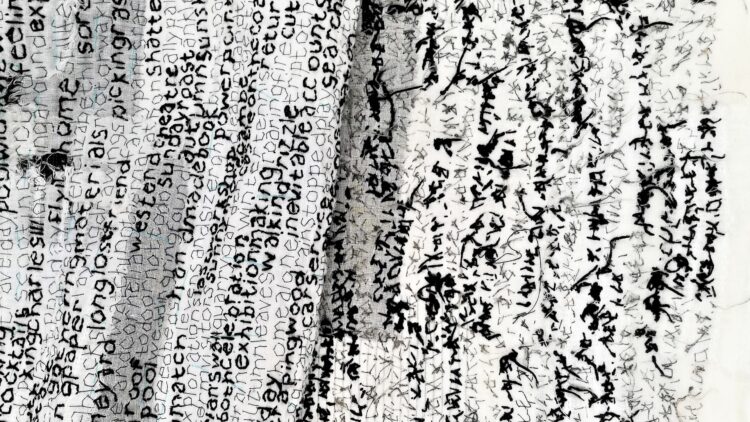
Make your art your own
Making art is not a competition, it’s a form of expression, and you should never feel you have to be better than others. We can all make art, and there’s no sense in trying to work your way up an imaginary ‘hierarchy’ of artists.
Remember, making art is unique to you, so create your art for YOU and YOU alone. If you choose to share it on social media, always create the work for its own sake, not for attention or applause.
Shelley Rhodes: ‘It takes a while to develop your own style and way of working, rather than an imitation of others. I always encourage my students to investigate, test materials and explore their own ideas.
‘I try not to make work just because I think it will sell or please others. Rather, I make from
the heart and to please my own artistic values. Having said that, another challenge when starting out on the path to becoming a professional artist can be the lack of money. I gave up full-time teaching to concentrate on my own work, but worked part-time in an administration role while developing my work, as well as teaching my workshops.’
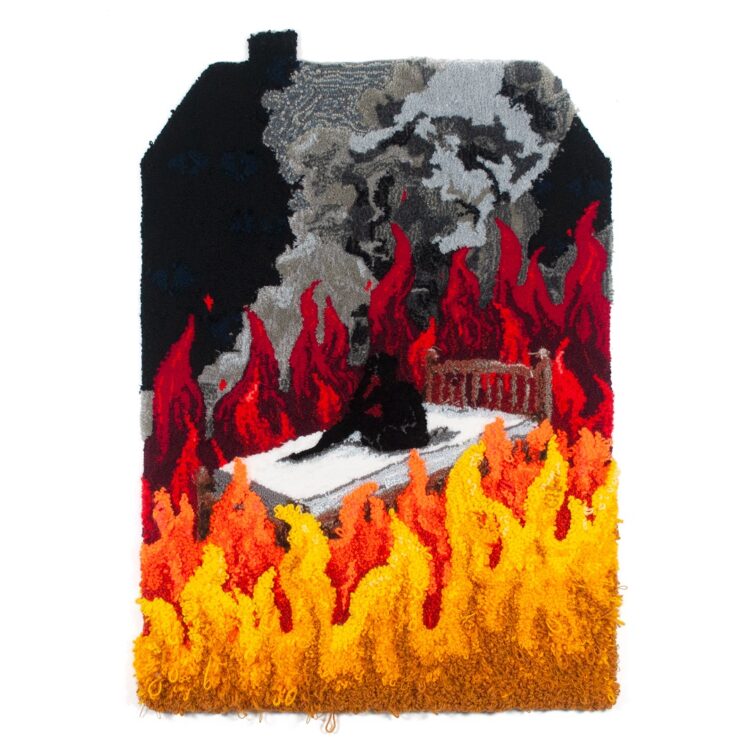
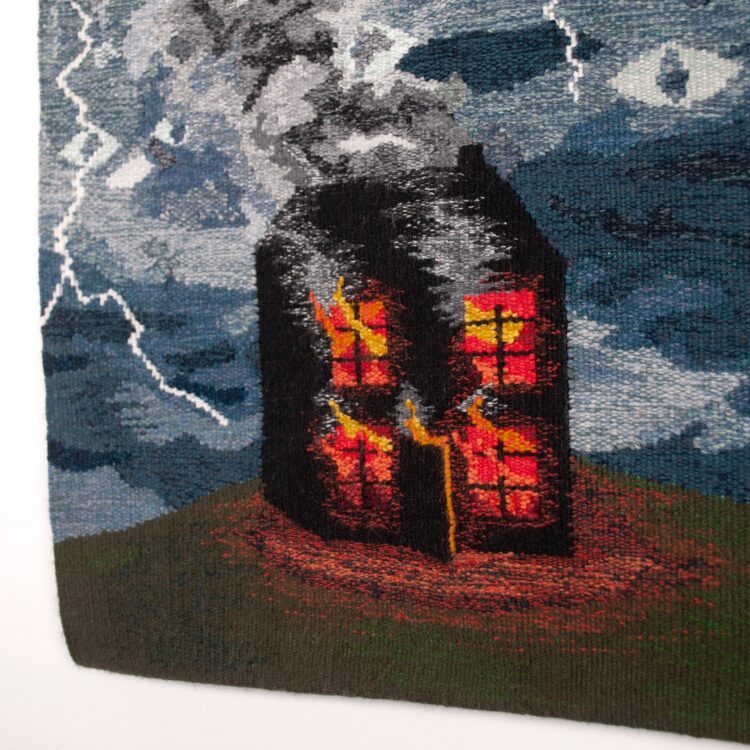
Molly Kent
One textile artist who has overcome many challenges is Molly Kent. Molly’s work is concerned with representing issues around mental and physical health through rug tufting and weaving. She focuses on our contemporary existence regarding social media and internet living, and how this affects our perception of self.
In 2018, while at university, Molly had a fall which led to a flashback and a return to ill mental health that had begun when she was 10. She was diagnosed as having complex post-traumatic stress disorder (CPTSD), due to previous trauma.
Molly had experienced bouts of bad nightmares and strange cryptic dreams. As she researched the condition and understood her struggles, she looked into dream psychology. She was able to use these dreams as a visual vocabulary, to construct narratives within her work that allude to the traumas she suffered and her emotional responses to them.
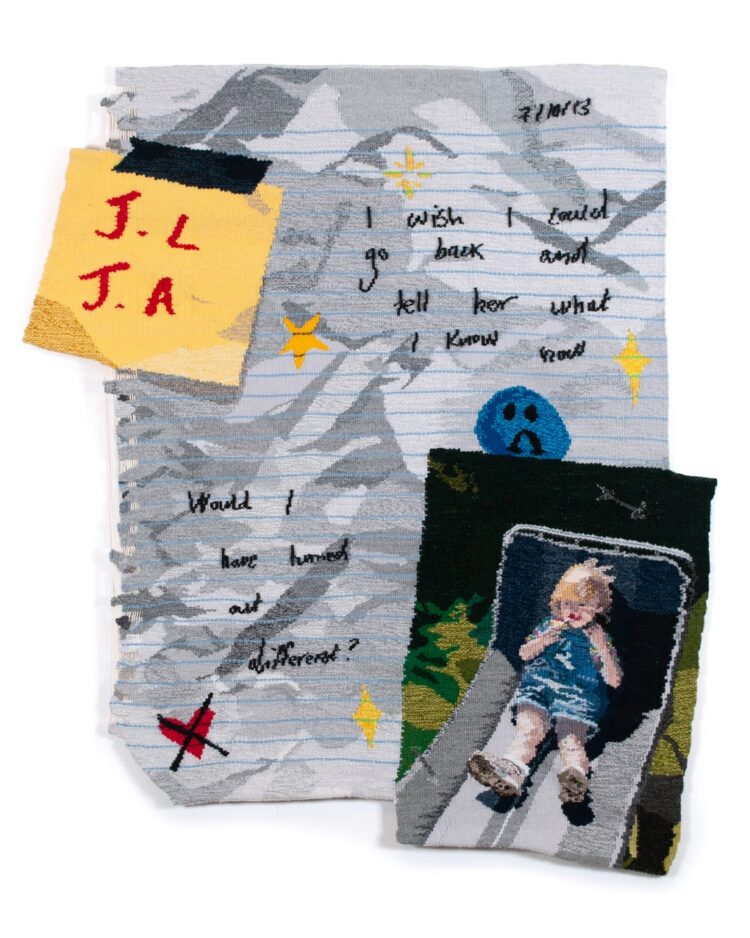
Epiphanies and dreams
In 2019, her final year of university, Molly produced a body of work Doubt in the Digital Age, which represented her personal doubts within an increasingly digital realm. As the pandemic ensued, her work took on a greater meaning as channels of communication and connection were mostly online. Molly completed her degree and was then furloughed by her employer, so she had more time to focus on making artworks.
It was then that she created Dream Weaving to record her CPTSD-related dreams and nightmares. She developed her tapestry weaving skills, not only to expand her methods of making, but also as a calm and meditative process, compared to the noisy and anxiety-inducing rug tufting process she’d used before.
Molly has a down-to-earth approach to her status as a professional artist – it mirrors the imposter syndrome or sense of fraudulence that some artists feel.
Molly Kent: ‘In all honesty, I still find the label of professional artist to be a strange one, I don’t really know what I’m doing most of the time, and feel like I haven’t really got the hang of being a career artist yet. But, from the outside, I suppose it does look like I’m a professional.
‘My journey hasn’t been linear or even consistent in many ways, most probably due to my mental health. But my CPTSD diagnosis, researching dream psychology and realising the effects of lockdown have propelled my work forwards in terms of the development of the digital aspects of my works.
‘I’m somewhat passive at going out and trying to seize opportunities first hand, so I’m grateful to many others for helping my development as an artist, including award bodies, private and public collectors, and fellow artists who have nominated me for awards or opportunities.’
‘I think the main thing that has helped my progress is simply continuing to create work in the face of multiple adversities, and making work that feels true to me.’
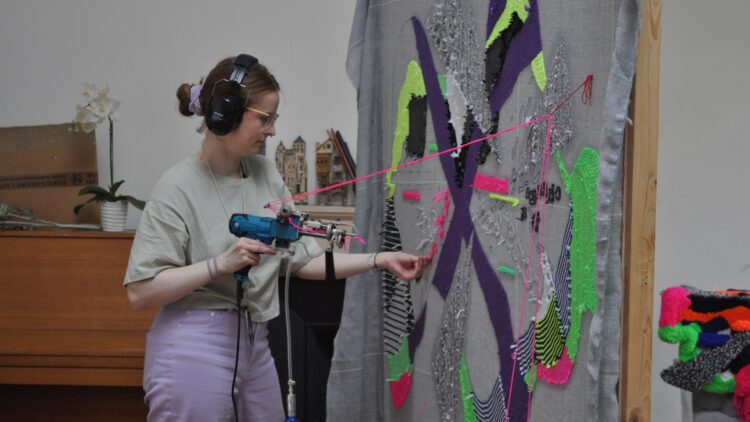
Molly Kent is based in Edinburgh, UK and has a MA from Edinburgh College of Art. Molly has exhibited at the Venice Biennale (2019), and her work has toured with exhibitions in Australia, Scotland and the UK. Her work is held in the University of Edinburgh’s art collection and the National Museum of Australia.
Artist website: mollyhkent.com
Instagram: @mollyhkent
Pay attention to the practicalities
Creating is central to your practice, but artists also have to spend time doing other things to support their work, whether it’s research, testing out techniques, sketchbooking, communicating with others, making applications, administration and accounting, or framing and hanging their work. So it is essential to figure out how to get organised and learn the technical skills you need.
Though these are all important, don’t forget that your key task is to place the focus on your art practice – give your art a high priority, every day.
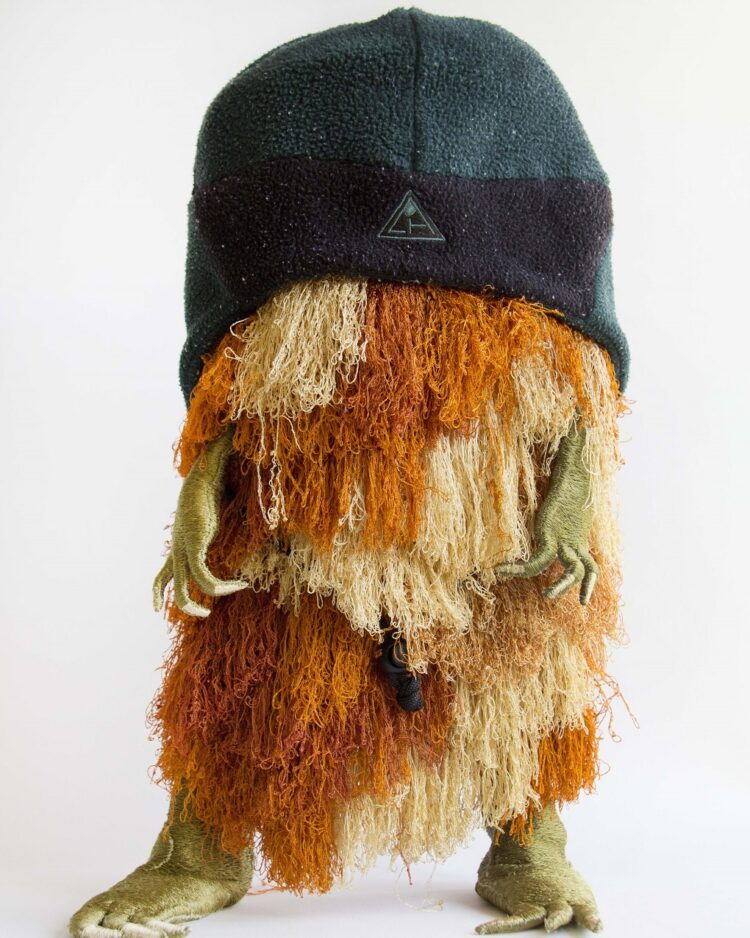
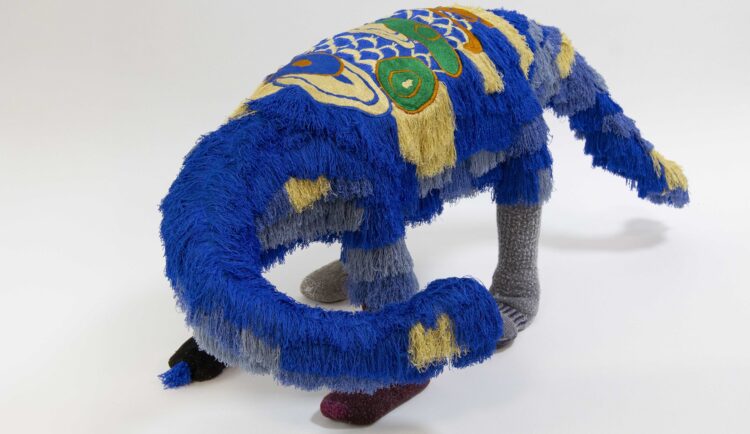
Woo Jin Joo
Woo Jin Joo is an award-winning mixed media artist specialising in soft sculpture. Her work challenges the value that humanity endows on objects in a materialist and consumerist society.
When she graduated in 2021 Woo Jin decided to become a professional artist. She felt some trepidation as she faced the responsibilities of balancing time, finances and the other practicalities that go with a career.
Woo Jin Joo: ‘I had initial uncertainties when deciding to be a freelance artist. Throughout my studies, I was completely absorbed in the medium and making – I knew wholeheartedly that my art brings me the most fulfilment. I was unsure about the financial viability of the move and having to navigate a career after being in formal education for so long.
‘However, I was really lucky to be awarded the Janome Fine Art Textiles Award at the Festival of Quilts in 2021, just a few months after graduating – it was exactly what I needed at that moment. It not only showed me that my work is appreciated in the professional world, but also gave me financial support to invest in my own free-hand embroidery machine and studio fees, giving me the extra courage I needed to make the transition.’

Part-time jobs
Initially, Woo Jin kept on her part-time job as a gallery assistant. She applied for opportunities to lead workshops and fulfil her desire to work in education. After a year or so she was able to leave her part-time job and now works as a freelance workshop facilitator, which helps to support her art practice.
Woo Jin Joo: ‘I always try to prioritise my studio practice but it’s a constant balancing act, with the added task of searching and applying for exhibitions, residencies, commissions and funding opportunities. There are a lot of administrative and miscellaneous tasks taking place behind the scenes to make a studio practice happen, but in the end I’m excited and energised by the fact that I can bring my ideas to life as an artist.’
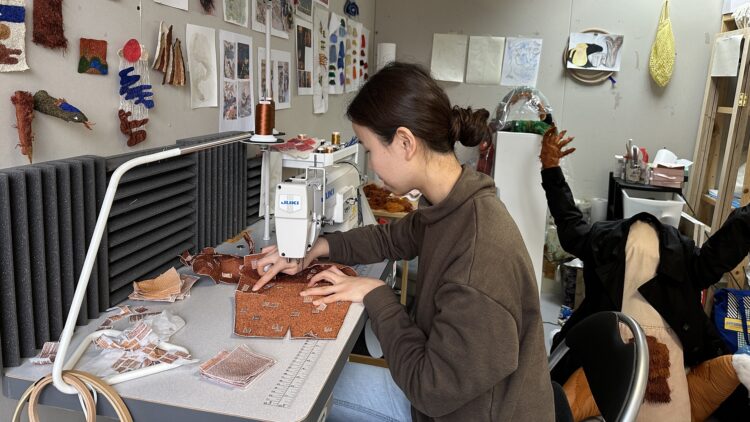
Woo Jin Joo is originally from Seoul, Korea, and moved to London in 2014 to complete a BA Textiles at Central Saint Martins, and an MA in Textiles at Royal College of Art. In 2021, she won the Janome Fine Art Textiles Award, and was shortlisted for Hari Art Prize and East London Art Prize.
Artist website: woojinstudio.com
Instagram: @woojinstudio
Get support
Going it alone isn’t always easy, especially if procrastination has been a habit of yours – it can be hard to ditch. You may need encouragement to find the motivation to stick to a routine or get the discipline to put down your phone and stitch.
This is where the benefits of joining a group can be enormous, whether that’s online or in person. When you interact with like minded artists, you begin to feel at home, motivated and supported.
Textile clubs and groups
Woo Jin was accepted into the 62 Group as an Associate Member, and Shelley Rhodes joined the Textile Study Group, which bolstered her path to becoming a professional artist.
Shelley Rhodes: ‘Being part of such a respected, national group has helped me to raise the level of my work and to be seen by a national audience. It is a very special textile group, as we work alongside each other on two weekends each year, led by a renowned artist. So I continually learn and develop skills within my practice. Not everything is relevant to what I do, but I think it’s always good to be open to learning and resolving ideas in a new way.
‘The group also requires its artists to teach, which continues to stimulate me and feed into my work. Also, thanks to the generosity of my students, I often learn things when I teach.’
Our artists’ top tips
If you want to scale up your textile art practice, then adopting the mindset of a professional artist is a step in the right direction. The artists we’ve interviewed have shared some of their best insights into practical actions you can make.
Danny Mansmith: ‘Use the internet for simple things, like sharing images on Instagram or joining an art group or co-op gallery. Look for like minded people to connect with and share ideas. It takes time to develop all the skills necessary to be a working artist, just keep at it.’
Shelley Rhodes: ‘I believe that one thing often leads to another, so get your work seen and have a presence on the internet, whether that’s through a website or social media. I was first invited to teach in Australia because the organiser saw my work on Pinterest, which subsequently led onto other things. And when I first started out, I had some work in a small local exhibition. A gallery manager saw it, which led to a solo exhibition. I like to let things develop organically over time. Sometimes you have to pursue opportunities, but often they come to you when you least expect it!’
Trish Burr: ‘Don’t hide your light under a bushel! Set aside your self doubts and think about how much pleasure you are giving others by sharing your work. We’re all capable of much more than we realise. We all have a creative sense; it is just a matter of honing our specific craft. Creating something original is one of the most satisfying and rewarding things you can do. No matter how difficult your customers or followers are, always be kind and helpful. They will appreciate it and become your most loyal supporters. Read the book Delivering Happiness by Tony Hsieh. It shows you how to live a life of passion and purpose, while literally delivering happiness to others.’
Molly Kent: ‘Try to consistently make and share what you’re doing, be it via social media, or by talking to fellow artists or curators. I find that people reach out when they’ve seen a new work on my Instagram feed, or through my website, which I update regularly. Also, have a sense of balance – despite being known as a professional artist, I don’t make a living wage from my art. It’s a balancing act: working enough to pay the bills, while leaving enough time to work consistently on my art practice.’
Woo Jin Joo: ‘Find a core narrative, interest and passion to drive and inspire your practice. Take time to rest, reflect and research – it’s not always about constantly producing. If you are looking to make your art your business, then register yourself as a sole trader, get a business bank account, keep a good record of your income and costs, and get public liability insurance. Maintain good working relationships with organisations, galleries, and people you work with. Don’t be afraid to put your work out there, you never know what could come of it.’
The power is within you
Many artists talk about finding a narrative. Reported as being one of the greatest films of all time, The Wizard of Oz is a fantasy containing many metaphors that may be worth remembering as we all tread our paths through life.
When Dorothy reached the end of the yellow brick road she discovered that the wizard she’d sought was an ordinary man who didn’t really hold the power to send her home. Along the way she learnt that she’d already got all the intelligence, heart and courage she needed – the power was within her.
You have that too. So, are you ready to follow your own yellow brick road…?
‘My formula for success was very simple: Do whatever is put in front of you with all your heart and soul without regard for personal results. Do the work as though it were given to you by the universe itself – because it was.’
Michael A. Singer, The Surrender Experiment: My Journey into Life’s Perfection.
We hope you feel inspired to approach your textile art practice with new vigour and that reading the trials, successes and tips from our professional artists has given you some useful pointers. If you’re still wondering where to begin, read our article Getting started with a new piece of work.
If you buy books linked to our site, we may earn a commission from Bookshop.org, whose fees support independent bookshops.
If you feel motivated to take your first step towards a more professional textile art practice, tell us more in the comments below.
















This article completely resonated with how I feel. I’ve been passionate about textiles and making embroideries for about 20 odd years. I’ve made a few pounds here and there. But always felt like a failed artist as I can’t make a living out of it. Last year I was given a dream commission by a friends relative. Long deadline, free reign. I couldn’t do it!! I fell into a severe depression for 7 months. I am much better now and sewing again, and learning that only when I create do I really feel alive. This book sounds amazing. I would love to read it. I think it would help me to complete the commission at last.
Hi Anna,
All I can say is you are not alone. Being an artist of any kind takes guts; I don’t believe anyone should consider themselves ‘failed’ for not being able to make a living at it, but I realise this is a difficult place to get to. I’ve been through many similar times myself and it’s still a battle – I have to do many different things to support my ‘career’ as an actor. Keep going!
Thank you Joe. Also a huge Thank you for the article. I am feeling inspired, determined and much more positive.
This article gives me courage to be more positive towards my art. Thank you.
I’m thrilled you feel that way Kathryn. I also read a very interesting book recently called The Happiness Advantage: the basic premise is that for years we’ve always believed that success causes happiness, but the author has done extensive research that points to just the opposite – happiness and positivity precede success. My point is that positivity (although not always easy) is the way forward! Perhaps I’ll write my thoughts on that book in a future article.
Hey fellow artists, sometimes it is hard to shield yourself from those out there who say “yeah it’s nice to have a hobby, but when are you going to get a proper job?”
Constant critisism, (usually from uncreative minds or even jealous ones) can wear away at your integrity and self-belief. Even if no one else give you approval each day, make sure you set a target, accomplish something, tick a box and tell yourself “GOOD ON YOU, YOU’VE DONE WELL TODAY, SLEEP SOUNDLY”.
Each day you will achieve more and gain the positivity back in your life.
Live by the rule “YES I CAN” It has made a huge difference in my life…………………
I love this mind set Caz. I’m going to start telling my self ‘yes I can’ too. Thank you for those words of encouragement 🙂
Jealousy is the horse the devil rides is all I can say– quoting an anonymous author.
I often got accussed by my parents of wasting time playing with fabric, & spending to much time on my hobby, when I had more important things to do. It in a way drove me underground, to this day I hide anything I’m doing & don’t show it to anyone.I wish I could feel better about what I’m doing, those voices are hard to escape.
I want to progress all the days. I want to learn but often you have to fight the environment because others think you’re wrong. I think before you can suceed in life you have to be happy: To be happy To be able to do, to be able to earn , attraction laws. Excuse my bad english ! Thanks !
Claire – I agree. Happiness is the key but latching onto it can be tough and takes discipline. Thanks for your comment.
The first part of your article describes me to a T; I am working hard to battle all those forms of resistance, with varying degrees of success! Another book that I have found helpful is “Art & Fear” by David Bayles and Ted Orland. This book also addresses some of the reasons for resistance and the necessity to get beyond them. Thanks for a thoughtful essay here; “The War of Art” sounds like a pretty useful book.
I think as long as we’re aware of the ways in which we resist, we’re on the right track. The War of Art is no-nonsense, but to temper it I also think we need to be kind to ourselves and forgive ourselves when we don’t live up to our own expectations.
Thanks Joe, great article. I own the book, so I’m not writing to win a copy. It had a huge impact on me. So many of the issues you’ve presented resonate, but I think the strongest one (for me) is: Professionals don’t over-identify with their work.
Once I came to terms with this, the ideas began to flow, I took chances and made giant leaps forward. I saw my profession as an artist as a privilege as well as an obligation. Are you familiar with this Martha Graham quote?:
“There is a vitality, a life force, a quickening that is translated through you into action, and because there is only one of you in all time, this expression is unique.
If you block it, it will never exist through any other medium and be lost. The world will not have it. It is not your business to determine how good it is, nor how valuable it is, nor how it compares with other expressions. It is your business to keep it yours, clearly and directly, to keep the channel open.
You do not even have to believe in yourself or your work. You have to keep open and aware directly to the urges that motivate you. Keep the channel open. No artist is pleased. There is no satisfaction whatever at any time. There is only a queer divine dissatisfaction; a blessed unrest.”
~ Martha Graham
Personally, I’m not entirely convinced about the ‘no satisfaction whatever at any time….’ . I have come to terms with finding satisfaction in things that I think could perhaps be more perfect. Which relates to the idea of ‘waiting for perfection’. But I love this:
“It is not your business to determine how good it is, nor how valuable it is, nor how it compares with other expressions. It is your business to keep it yours, clearly and directly, to keep the channel open.”
My mantra, for some time now, has been/is ‘keep the channel open’.
suzanne
Thanks so much for this Suzanne. The Martha Graham quote is beautiful and apt. I agree with you though – I think that one of the reasons we do what we do is satisfaction. Satisfaction is different to applause and accolades; it is personal. I think I may well ‘borrow’ your mantra. Joe
I began to read this article and wondered how the heck you got into my head and found out my secrets. I have to read this book and gain the courage to dare to fail.
Hi Patti – remember failure is an essential part of success. I struggle with this myself, but am becoming more and more open to it.
Oh my, how timely. This article really resonated with me. I’m currently taking an online Artist Strength Training class with Jane Dunnewold and we are discussing similar things. It helps to know other artists struggle with ‘resistance’ in all it’s forms. And not having a website because I’m waiting for the perfect group of art pieces…just another piece of resistance. Thanks for sharing this book with us!
We love Jane Dunnewold. Her teachings are inspired! Thanks for the comment. It’s a while since you commented. Is your website up yet?
Fabulous post. I have been wrestling with the craft vs art conundrum and this helps tremendously – thanks. Now I have to read the book
Doing what you love is difficult if you feel judged by it BUT often the judgement is in our own minds, don’t you think? Whether it’s craft or art what does it really matter if you love it?
I really identify with all these things and would love a copy of the book. Although I definitely create because I love to, I also create because I have to ! The feeling comes from within until I have no choice but to create and then the pressure is released and I am happy. 🙂
I’m interested are you always compelled to create or do you ever struggle?
I love this list. I am going to post them in my studio and use them as a set of goals for professional growth. In a nutshell, they certainly resonated with me. It is always good to see the information we all know and struggle with in another format. It helps to elevate my being to the next plateau!
I’m so delighted the article resonated and hopefully you’re well on your way to achieving these goals!
Sounds like you had incredible parents as role models. It just reiterates that we must be artists for the sake of it – not for money!
I have always know that I’m not happy unless I am creating. I think the idea that being a professional artist isn’t entirely tied to the ability to support yourself with your art is freeing. Thanks for the article!
I think professionalism comes in many forms. There are many people earning a living from their art who perhaps aren’t professional in their mind set and vice versa!
I think professionalism comes in many forms. There are many people earning a living from their art who perhaps aren’t professional in their mind set and many who struggle to make ends meet but are resolute in their need to create!
Many of the concepts in your article resonated for me. I first learned the names for my feelings and behaviors almost ten years ago in the Seriously Creative program led by Mary Holdgrafer. I have been consciously questioning what it is I am resisting and why ever since. In my case it seems the lessons need to be re-learned more often that I care to admit. However, I have learned to be more patient with myself, and I value the insight of each new teacher. The War of Art sounds like a session with a ‘kick in the pants’ teacher — something that works for me.
Patience is important. I think we need to be kind and tough with ourselves in equal measure.
I read the book back in January when I was in a bit of an overwhelm (there are so many art events in Miami in the winter) and needed to stay focused on my own career goals. It strengthened my resolve to continue on my path with a few tweaks.
After I read it, I passed the book along to a friend in another state so I no longer have it in my reference library. Had I kept it, I would refer to it repeatedly.
Thanks,
Pamela
Great to know it made an impact. I think it’s time for me to re-visit it myself.
This article has hit home as it opened my eyes to the fact that what is often standing in my way is my ego. Oddly one of my meditation goals for this year has been to overcome both my ego and my jealousy and be truly happy for the successes of others, happy for my own, and okay and able to move on from my failures!
Yep – ego will get us every time. I’ve been experimenting recently with going more with my instinct whether I feel like it or not. It’s something I learned from this book: The 5 Second Rule: Transform your Life, Work, and Confidence with Everyday Courage
Great article. It reaffirms what I know to be true – an artist creates because it is their passion and is as fundamental to them as breathing. Being an artist is about working consistently and knowing that progress does not come from lightning bolts of inspiration, but rather through objectivity and thoughtful analysis (from self and others) and the bloody mindedness to keep going even when things don’t seem to be working.
I am a mature age student about to finish my Master of Art and go out into the big wide world. To think and act in a professional way so that I may exhibit my work as an artist is the dream I have nurtured and am about to see realized. Its a big scary world out there but with determination, and hard work I will get there. The article just confirms ideas that I know to be true. Thank you
,
Have just finished my Diploma of Textile Arts (Melbourne, Australia) I am at the cross roads of being an amateur or a professional artist. After our graduate exhibition I am feeling a lot of the forms of resistance ! No longer being in a class room environment I need some guidance and direction and this book sounds as if it will provide just that.
It’s true – we need structure for creativity and it can be tough when you need to make that structure for yourself. Setting up boundaries and rules for your practice can help, as can a system for creativity.
What a great article. With a day job and a passion, i understood all that you said. What a great book. I will have to get hold of a copy. Fingers crossed for the draw.
I need this book to help me figure out where I am & where I am going with my art. Do I have it in me to be a professional. I have had some successes; I LOVE textiles & derive great joy from creating. Why then do I shut down for extended periods of time?
Thank you for this article! I have been procrastinating a book about textiles for more than a year, it makes me think about why I can not finish it, I got almost everything done, but there is something that makes me feel stuck. I need to read this article one more time and meditate about it. Thanks again 🙂
“Resistance feels like unhappiness boredom, restlessness, guilt”
I recognise ALL of these symptoms! What a great article. It was written for me. I feel like I have been striding restlessly along the top edge of a cliffface starting down too scared to jump. All I do is climb down tentetively and then back up again and carry on pacing backward and forwards staring down at the valley below.
Thank you.
Jo
“We tend to narrowly define ‘being a professional’ as being able to make a living at our craft.”
I have always struggled with this concept and now I ‘see’ ! …. I am professional in the way I work, I just don’t make a living with my work !
So many of these points hit home and I’m glad to see them in print … but I really want to work on my ego, as I like to share what I know and do, and I love when viewers appreciate the spirit of my work … hate to think I’m being a show-off.
In defence of EXCUSES (my life gets in my way everyday), “Tolstoy had 13 children and still managed to write War and Peace!” … well !, he wasn’t doing dishes, cooking meals, cleaning house or caring for them when illness struck, all while raising 13 kids … his wife was !!!, enabling hubby to write such a classic and claim such glory. Just saying !
Wow, I am so glad I read your article … thank you !
Was thinking exactly the same thing about Tolstoy – I’m sure he didn’t do the hard work of the child rearing!
Thank you for the article. I read it and it gave me urge to keep on keeping on.
One can be professional in attitude and make their living, or be professional in consistancy and discipline. But when I hear the phrase professional artist, I think, earning their living from their art. I don’t think artists should let that one concept-being a pro-come into play. i think if serious vs. not serious. If you’re serious about your art, you do it, you nt think about doing it. I say this harshly from the vantage point of age 60, and seeing what friends made their art no matter what came up-family, a job, illness-and who kept waiting till they nad the perfect studio, the most peaceful afternoon….I was a textile designer and then an accessory designer for years. I earned my living from that work, and that’ll cure one of procrastination, fear, the whole thing. I was employed by companies, and I also worked on my own. Designing is a form of art, but it’s for commercial reasons, so one is obliged to meet the needs of a client or boss. The end. That is one way to be a professional. One can’t last if one can’t pay for housing and food by one’s output. If you consider yourself an artist, with no commercial concerns, you still do need to do what this piece stresses-your art. If you sit there long enough, something will happen. The mistakes and the missteps are the things that lead you down the path in a direction you may not have ever thought of. Now I’m a writer and the same rules apply. As for making a piece of art to “match a sofa,” many interior designers need work that “fits” a client’s needs and while it might not be the romantic idea people have of being am artist, most well-known or successful artists have taken commissions and work with the buyer on concepts. If you don’t need to earn any money from your art then you can do whatever you want, and for many people, some of their is art just for themselves, and their other art is geared towards a market to pay for a studio, supplies…and time! Very lucky people can sit in a studio, or walk outside with a camera, do what they do best with their own vision, and support themselves by only doing that. Being a professional artist is like being a mechanic-if they didn’t go into the garage with a set of tools, they wouldn’t get anything done. I do think that the author understands the insecurities and boredom that all creative people face. The thing that helps me the most is to find interviews or articles about the struggles and work habits of artists I admire. Just saw cartoonist Roz Chast speak and she said that she has to do something like 200 cartoons (or more!) before one gets into the New Yorker.
I am 56. It’s time. Thankyou.
I need this! I am an artist! I also need my family to understand I’m an artist. I love to share my knowledge about art & techniques.
I also have plenty of excuses and being a wife & mother always comes before my art.
If only I had more hours.
Thanks for the great read.
Thank you for this great article! I’m a quilter and textile artist and couple of years ago I opened a fabric shop with hope that I’ll be doing what I love but instead I became a shop keeper!! And I think I was creating more from my heart when I was employed than now when I’m creating for living. And then there is the craft / art war inside and around me!! It would be lovely to win the book, thank you for the opportunity.
I’m new to this website and this is the first article I’ve read … I picked a good one.
As with everyone else I’d love to win the book or if not, buy it myself and read it. I hope it’s a quick read because I have the feeling I will be wanting to get back to my studio ASAP! Wonderful dose of inspiration, thanks.
Hello Maria,
Are you the daughter of the Jorge Gallardo born in 1924? I have been trying to find more info on him as I believe I May have one of his oil paintings. I have only been able to find a limited amount of images of his work online, but the signature on my painting looks remarkably like his. It is a painting of a church dated 1980, could you direct me to a site where I can find more than just a few images of his work. If you would like to see an image of the painting I have , I. Would be happy to send it. Thx michaeljfo@comcast.net
My resistance is constructed of feelings that I don’t know enough… yet. I have to exhaust the possibilities of each new fabric, paint, yarn, paper, dye, ink I possess, and then acquire more, before I allow myself to create with it. What if there’s another way of doing something that I haven’t explored yet? Maybe I’ve missed something. What if I tried using that stuff with this bit, and vice versa, first? …and then I procrastinate because I don’t actually get round to completing the endless experiments I dream up for myself. If I don’t know what I’m doing I’ve got no right to create in ignorance. I torture myself and I’m my own worst critic. I’m 60 this year and it’s about time I gave myself permission to just enjoy the process.
Janet, I can relate to this kind of resistance. We also don’t want to “waste” any of those new precious materials. One thing that helps me over that is to give myself a 30 day challenge to create for 15 or 30 minutes a day, to just play. Play with all that fun new stuff. Everything doesn’t have to be perfect and it won’t be, it doesn’t even have to be a little bit good. I found it very freeing the day I made friends with my trash can. Fabric, paint and thread can be replaced, and it not wasted because you will learn something new and get inspired with each session. Some of my favorite pieces were created, or at least started during those times, when I gave myself permission to just enjoy the process.
I will be 64 soon and have also been struggling with resistance for a while now. I think it’s time for another 30 challenge. Maybe for both of us?
Thank you Joe for your article on Steven Pressfield’s book – The War of Art – what a great title. I ordered it and read it in a day. Very encouraging for self discipline, self awareness (as opposed to hierarichal orientation seeking others praise/approval) and loved his Supreme Virtue “Contempt for Failure”. We do make our world a better place when we try…..that’s all…….just try……the path is not a smooth one but the lumps and bumps contain much beauty. I have come to appreciate that intentions won’t satisfy, only efforts will.
Wonderful Angie!
I am a french lady who has been very moved by your text. It is so very true…. My sister is a professional artist and I recognize her in the définition you give of a professional artist. A few of my friends are, some would like to be…..what about me? I am the one who doesn’t dare be cause she is not self confident!!! And why not? So many reasons…admiring my sister is one, having been a teacher is another one, whenI show my textile work people often say it is moving or very personal or good; some probable don’ t apppreciate. But I am the only one responsible for postponing, finding awfully bad excuses for it….. Nevertheless, inside me I feel the urge to use my bands, threads, fabrics. I think what is most important is to dare, to admit failure, to be self confident! I have improved but I will read the book to get rid of this blocking resistance! Thank you so much of “shaking” me. Joëlle
What a great article and review!! A great pep-talk on overcoming resistance in all it’s many forms. I would love to read the book!
i am a seed bead embroidery artist and do my best work immediately upon waking up. While my hands are still calm and my mind has not taken on to many “avoidance” tactics..i sit with my beads and see what comes before my nine to five job calls. Having a “regular” job can make getting to any art project more of a challenge but we can’t let it stop us! It can’t have our soul!
I love that about “doing art for the love of art” (my paraphrase). If we keep waiting for something to sell or to get paid for our genius our art may never happen. Don’t stop creating no matter what. Thank you so much for this wonderful supportive article and all the fantastic work at textileartist.org!
My gosh! I started to look around the room for the video cameras! My world and feelings explained! I really look forward to reading this book and beating the things that plague my creative process and progress! Thank you!
Brilliant article. Insightful and inspiriting. I’ve ordered the book! 🙂
I do understand we need to really want it; there are ways to make a living out of our passion and if we really love it, opportunities like teaching in adult education, making kits, opening an online shop or even a business are out there;
Just to add, I love hand embroidery and other textile crafts; textiles are warm, tactile, shiny and this is what makes them gorgeous; the people who are most famous of doing hand embroidery to the most professional level – for example Mary Corbet and Trish Burr, never had official college training in the art, but obviously are very committed and talented individuals;
I loved this article, ordered the book, and read it in 2 days. It’s an easy read, and quite funny in places. It has helped me to focus on what I want to achieve with my art. I am always much happier and satisfied with the result when I create from my own inspiration rather than what I think people would like to buy. Thankyou for the great article!
Hello there, thank you for this, it has helped me just when I need it.
I have ordered the book. Synchronicity is at work here for me.
Been ‘resisting’ for nearly 25 years, it hurts like hell. No more.
If it’s ok I might leave another comment after reading the book….
Thank you ever so much for writing this and from the other comments it looks like I am not alone ! Even if it feels like it sometimes !
So pleased you enjoyed the article – please leave another comment after you’ve read the book – I’d love to hear your thoughts.
All the best, Joe
This was very interestng to read, and I think that most of it fit perfect on me too.
I’ll come back and read it again, later.
This was exactly what I needed today. I just had a problem with my taxes because I don’t know my inventory. I got so upset and I really wanted to just quit trying to do my art as a business. (I know I can not quit being an artist because that is what I was born to be.) Reading the list of what it takes it became clear that my major problem is organization. I knew it was a problem but never saw it as the source of so many other problems until now. So now I have a new goal for the year. Thank you.
Hi Diane – How are you getting on with your organisation goals? I think often as creative people we feel like boundaries will hold us back, when in actual fact they can be great for productivity.
I can totally relate to so many of the posts. My biggest problem is a fear of just not being good enough. I even take praise as people just being polite!! I am working at trying to break through my fears but it is hard.
Fear is a productivity killer! Clear guidelines and a system for creativity can help push through the fear. I’ve recently read this book: The 5 Second Rule: Transform your Life, Work, and Confidence with Everyday Courage It helped me understand that we will never be free of fear, but we must act in spite of it and on instinct!
It helped me understand that we will never be free of fear, but we must act in spite of it and on instinct!
Am intrigued by the article and will read the book. But what amazed me are the comments. I guess I thought I was the only procrastinator out there! I am encouraged to know that I am a member of a tribe– but now must work my way out of it!
Yep – I think having such access to everyone else’s success (particularly on social media) makes us feel like we’re the only ones not achieving 100% of the time! It’s not true – we all procrastinate, even the most productive people in the world at times find it tough to get going!
I will have to get the book! The articles are written for me! My husband died last year, and whilst he was ill, I stayed with him rather than going to work in my half- completed studio and now I still can’t go to work there because I tell myself that the studio needs to be finished first! I’m the greatest procrastinater (is there such a word?).I need impetus to start working again, and it helps to belong to an art group that has open studios once a year and other titled small exhibitions, the latest being the Circle of Evolution. There are quite a few issues quoted that resonate with me that I’m very keen to work on, one of them being the need for validation as an artist from someone I respect. Whether I win the book or not, I’m going to get one and choose a mantra that I can respond to, and put it up on th studio wall.
Hi Helen. So sorry to hear about your husband. Did you get the book and did it help motivate you?
Hi
Like many others who have read your article and left a comment, I can identify with all of the forms of ‘resistance’ listed but particularly ‘waiting for perfection’.
The article has given me a lot to think about so I thank you for that. Whilst it isn’t a good thing that many others recognise themselves in what you have written I do take some encouragement that I am not alone in thinking and behaving in this way.
It is all too easy to feel that you are the only person who struggles with these things, so I also thank those who have been honest enough to share this.
Lots to think about but even more to ACT upon me thinks!
t r a c y
Waiting for perfection is something I have struggled with too. We really must put our necks on the line though and let ourselves be somewhat vulnerable. If not now, when?
I need this book too! I am a professional artist and have been for over thirty years, but unfortunately being ‘professional’ doesn’t mean that procrastination, task avoidance and fear stop…they don’t. Sure, I still make work but being a full time professional artist doesn’t make it any easier. I’m still sitting on the computer not doing my tax return, or finding other things that are more pressing (walking the dogs) rather than finishing a drawing, because there are no immediately pressing deadlines. People ask ‘what inspires you’? …and I tell them, only half jokingly, ‘a deadline’! Outwardly I may look like I am doing ok, but in my head I am battling demons every day instead of achieving what I really want, which is the same thing we all want…happiness and joy in what we are doing and how we are living. Maybe this is the book that can save me, or at least give me a push in the right direction.
A deadline can be a great motivator! When we have to push ourselves on with nobody expecting anything from us it’s tough. I have had a full time job for the past 3 years (the first time I’ve ever had that in my life) and it was actually a relief in some ways to not have to be disciplining myself all the time. Whilst the job was creative in nature and I got great satisfaction from it, I’m now back to being self employed as I need new challenges! So what I’m saying is I understand your plight – did you get the book?
Hi Joe
Pressed the link on Twitter that brought me to your book review, I must buy it!
I’ve read your article/s and love your ability to write so eloquently, telling us exactly how it is! It’s True – Resistance is an issue and not just for me!
My art flows because I have a passion to create; using textiles to raise issues regarding the over abundant manufacturing of cheap disposable clothing, ending up in landfill.
Secondly I rescue and keep ex-battery hens and over the years I have learned about the plight of these intelligent girls who are being used as a machine to lay eggs and then killed once they are spent. It’s a life worse than death for these ladies! Tragically, approximately 50 billion chickens are raised mostly for meat. They have a life of misery for a few weeks and then are dispatched as food full of chemicals in many cases. As my compassion has intensified it drives my textile art work because I want my artwork to be seen to tell the Story, to gain more respect, more appreciation and to view Chickens like we do our cats and dogs as pets because chickens have an intelligence of maybe a toddler age 4 years old.
So when I hit a resistant barrier I look outside into my garden a view my family of free range chickens.
Chickens are a therapy, my driving force, my life!
I gave up my day job for them, I now keep going, creating a business for the loves of my life, chickens and textile art!
My son in London finds my passion somewhat of an embarrassment. He doesn’t want to admit to his high profile clients what his mum does for a living!
He wishes I created images of Tigers, elephants or other exotic creatures! This resistence in his mind affected me for a while, it knocked my confidence. I’ve come to terms with his lack of understanding and knowledge now and I have recently explain it clearly to him.
Why I do what I do is because a ‘chicken’ is my pet as are my cats, I love all animals, I don’t want to eat any animal.
A chicken in my Artwork in this sense of meaning to me is a ‘metaphor’ for life and for justice! Using my textile art daily is an exciting and pro-active way to raise awareness for chickens as pets not products!
I do love to show off my art on my website, through galleries and at exhibition because I want my audience to think and to talk to me and to ask me, Why Chickens?
I am honoured knowing that I have made a difference!
Great work Joe, very inspiring article, thank you and your audience for reading my comment.
Blessings and happy new year to you all
Jane
Hello Jane – Firstly I really appreciate your kind words about my writing – it’s something I’m really passionate about and want to make more time to develop.
And what a fascinating story – I think the commitment you show to your subject is admirable. You deserve to be appreciated and so does what you make!
Steven Pressfield gets inside us ‘artists ‘heads & has blown fresh air through mine. As a passionate designer/maker in ‘preloved’ textiles I put quotation marks round ‘artists’ because so many people still baulk at the idea of recycled fabrics,never mind actually purchasing an item made from them. I include some of my family & friends in this mindset. For example in my village there is a group of accomplished artists who have organised themselves into a group & hold Open Studios. I know one or two in this group & I have not been asked to join. Neither have I made a request to join,because rejection would knock my confidence back perhaps permanently. I know my creations are great,unique,quirky & affordable & they sell! Maybe it’s time to make that request,I think I’ll go for it, any thoughts anyone ?
Barbara – I’m sorry I’m replying to this over a year later but I wanted to get in touch to see if you did make the request? I’d love to know. If not that group then join another – life i full of rejection and it’s important not to equate that with self worth. This is something that is always a struggle for me too but I’m working at it constantly. Be well.
just taken the time out of my ‘busy’ schedule to read this article which totally resonates with my work ethos – such had disciplines to overcome and keep up when there also many other life factors to deal with …. I think especially for women artists who want a family as well as a career ! Have written down – ‘Professionals are …’ in my sketchbook as an affirmative reminder ….
Great idea re: sketchbook. I’m not a woman but I certainly try and do too much – I’m learning to streamline and commit wholeheartedly to just a few projects but I get easily distracted when something new and shiny comes along! Always a work in progress I think.
I’m glad I stumbled upon this article I’m a songwriter and I have written two unpublished books and you hit right on the mark with this one. I’m pro in the mindset but no cash flow. Thanks for reading in advance.
Hi Chelita – welcome! Glad the article resonated.
I take my art so seriously, yet it is true, I often procrastinate. Thanks for the article. I finally have gotten to the point that I realize I LOVE the creating process, and it’s much more than a hobby to me.
Procrastination is epidemic in the modern age. It’s important to forgive ourselves some of the time but not let ourselves off the hook all the time I think!
This is a great article. I glad I don’t procrastinate, I create every day, tidying my work space only happens when I can’t find something vital. I still work at another job but short hours and I am reducing hour each year. This article is food for thought. I’ll have to get this book to keep on track.
Hi Sonya – sounds like you have the drive which is essential isn’t it? Are you still a your job? I’d love to hear where you are on your journey now.
Thank you for this article. It’s rather nice once in a while to have one’s own beliefs validated. I know I’m a professional artist, have no problem with creative ideas and can be very selfish when I want to press on with a piece of work as everything else goes out the window!
Creative art is a funny thing, a bit like an addiction, you just have to do it! You don’t do it to please others and when you’ve done it, you don’t necessarily like what you’ve achieved, you just knew you were driven to do it.
I just wish I had the same drive to get my work out there!
Anyone know a gallery that would be happy to exhibit narrative kimono?
Hi Deanna – can’t help on the gallery I’m afraid but I do think you could try applying some of the discipline you clearly have for your process to the promotion of what you create. It is made with passion and deserves to be seen, shared, appreciated! Go well.
What can I say? Sometimes things just come around to you at the ‘right’ time, I feel as if the author has just taken the sentences out of my head, almost word for word and it has made me sit up and take note. I NEED this book sooooo much.
Hi Margaret. Did you get a copy of the book? I’d be interested to hear if it made a difference.
Hi Joe, I feel like I have been at war with my art all of my life-veer 40+ years!. Everyone thinks you have to make a lot of money to be successful at art, yet I still struggle along and pull in drips and drabs from different sources. My artistic common its considers me successful. Maybe this book will help me get over my shortcomings
It’s tricky not to judge our success in monetary terms because it’s such a solid measure unlike the satisfaction we garner from what we do, but it sounds to me like you are doing exactly what you should be doing – keep on keeping on!!
This article totally resonated with me and how I feel towards my arts/crafts practice. It is the book I need to read for guidance and support right NOW!!!
Hi Brigitte – did you get the book?
Yes, this article resonates with me too: as my artistic work is not sufficient at all for my living, and truthfully I do not apply myself regularly every day, I am “ashamed” and don’t present myself as an
artist…. What a way to go…..
I admire you all, wish you a steady development and SUCCESS, whatever this means to everyone of you, and a big THANKS to the author of the article, JOE, with contributions from the Book of STEVEN PRESSFIELD. >My God, I have so many books to read on DOING ART, by now!
(Sorry for my imperfect English, I am Italian!)
I bless the brothers who have founded and are promoting TEXTILE ARTS Org: As far as I know (and I spend a lot of time online) THERE IS NO SIMILAR ORGANIZATION in Italy and I am hungry to read all what arrives from them. Keep up with agnificent work.
Thank you again
Irene Romanelli, vintageliving@libero.it
Thanks Irene for such a lovely positive comment. Yes – I too have a penchant for collecting books (so many unread!!!). We are only human and can’t do everything all the time – it’s about prioritising and doing what’s truly important to us I guess. All the best.
This is a great article, especially regarding the fear and ego factor; and the discipline of disregarding distractions. I recently purchased a house and put my artwork on hold for 2 years. Now that I am back to creating, I fingmd it immensely difficult to get off the internet addiction, but feel fabulous when I am stitching. I find it a process of basking in the rewards of my work and ignoring the emptiness of online pursuits. I would love to have this book as it is more concrete than esoteric.
Lisa – the internet is a wonderful resource but it can become a addiction can’t it? My downfall is Facebook – I could quite easily whittle away hours if I allowed myself but there’s no real satisfaction involved. Isn’t it funny how sometimes the things that bring real rewards (like how fabulous you feel when stitching) are the things that are hardest to get down and do?
I just got the book yesterday and it’s amazing! Clear, direct, meaningful! Thank you for talking about; I’m ready to buy “Turning Pro”
What a fabulous article and like most or all artists, I have felt or feel like this a lot of the time and I am only at the beginning of my journey into starting my own textile art business. But teaching lots of these replies and comments I don’t feel alone… It is so hard to make a living from art, but like a lot of comments on here once I am stitching, in my little world, creating…I am happy and where I want to be… Some days it takes a lot to get there as life gets in the way, or I let it, and I don’t get a lot achieved which is when we feel the pressure and overwhelmed and start to feel down. I must have to keep reminding myself this is what I love, put myself and Stitching first and get on with it!!! Thank you for all this support I get so much inspiration and guidance from this forum.
Joe, thanks for this article, a really meaningful way to consider my practice. I am just about to open my first solo exhibition and it has been a journey fraught with fear. I can handle the fact that people may not like or buy my art but, conversely, I am afraid of their possible opinions of me. This is the time to remember that I am not my work! The points made here about over-identifying and self-validating are really important as it is easy to lose track of yourself in among all the work.
Thanks for this great website, truly appreciated
Great article! Am printing it out to look at frequently. Could that be procrastination??!!!! But I have to take issue with one thing – I bet Tolstoy had virtually nothing to do with the raising of his 13 children, other than pat them on the head at bedtime! Keep up the good work, guys!
Fantastic article, thank you. I think I have always had an artistic mind, it’s just that I didn’t have time to explore it while I was working. Long hours and stressful job. I retired nine years ago and and have found a love for textile and mixed media art. Having worked at it for nine years I am at last ready for my first exhibition in a weeks time. I have 36 pieces to show, whether I sell any or not it doesn’t matter. I will be there to greet people and answer any questions. If I sell a few pieces that will be a bonus.
Hi Joe,
I feel might be a bit ‘late to the feast’ , as you wrote this article so long ago. I felt I must reply as I loved what you had written and it resonated with me on many levels. I been a theatrical Costumier for many years and earn my living now as a bespoke dressmaker. I’m very fortunate that I have been able to use my skills to support my family and home. However, as a single parent I have had to put aside my personal creativity to realise my clients wishes, and this has resulted in a huge frustration. I took a long time to understand what was missing in my life – I needed to be able to listen to my own voice and my own creativity. So I am finally taking steps to find a way to do this through my textile art.
But I understood your article on another level too, as I was ( and very very occasionally still am) a professional actor. I always struggled with the concept that I was my product. I hated that , it completely tapped into my ( common in actors ) insecurity and actually stopped me pushing forward on occasion. After retraining as a costume interpreter I found a marvellous freedom . I had no problem promoting my work…. i could find the distance to let the work stand as a piece on its own. I wasn’t taking any comments as a personal criticism. So, your words gave me a wry smile of recognition.
I love this site! You have created a wonderful resource and I am so grateful. Thank you.
I have just read the article. It was fantastically written and provided much food for thought. As I ticked off the modes of ‘Resistance’, what I realised was that Yes to be a professional takes time, activity and not just wishful thinking!! Also, I am not alone with these modes of inaction and a decision needs to be made today professional? or hobbyist? Thank you Joe and now to work!!
Oh my, woke up this Monday feeling like I need to find a way to get going with all the creative projects swirling around my head ,but feeling stuck ,Why? ,what am i waiting for?, the “right moment”, the perfect space to work in”, and all the other self proclaimed obstacles, …”after I do the spring cleaning, after i do the cooking, etc etc…
Then I found myself reading this article and it was as if my thoughts had jumped into this amazing room, filled with fellow travellers,all asking similar questions, all on a similar quest.
I realise that the so called “obstacles” to my creative journey are my way to avoid dissapointng myself,What if the idea in my head is not transferable,the outcome is not what I expected?, What if Im not “good enough…dont know enough…”. Then reading all the comments,responses on this page ,an epiphany of sorts, my creativity is not about meeting expected standards or artistic rules, is about SELF EXPRESSION, using whatever tools,skills I have aquired and most importantly, the LEARNING process, which should never end, so as I prepare to put thoughts and ideas into visible forms, I am giving myself permission to Experiment, to succedd or to “fail” and then try again.
No set rules,no self limiting doubts,just courage to DO.
Thank you for your wonderful community and always inspiring articles.
Written on a cool end of Autumn afternoon in Melbourne ,Australia
Really appreciated these articles. I’ve felt stuck for ages, far too much procrastination & sabotage. I hope to re-start with the regular / daily discipline of play time & see where it leads. Thank you all
Your words have a way of uplifting my spirits and restoring my faith in humanity.
Hi, which is ‘the’ book that everyone is referring to in these comments ? There seem to be a lot of books mentioned.
Thanks
Hello Ann, it’s Steven Pressfield’s book – The War of Art. Best wishes, Amberley from TextileArtist.org
This piece was informative and had a nice, gentle way of guiding the reader through your points.